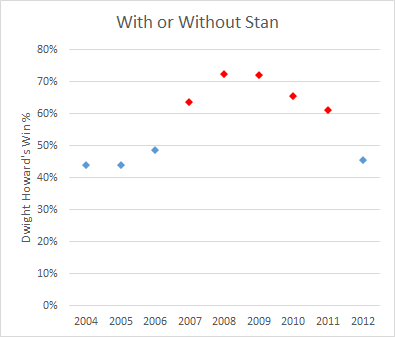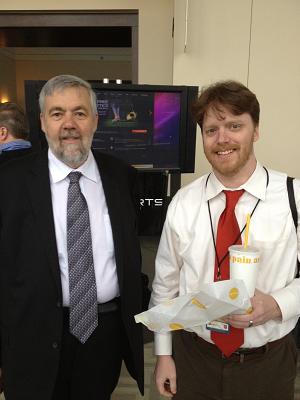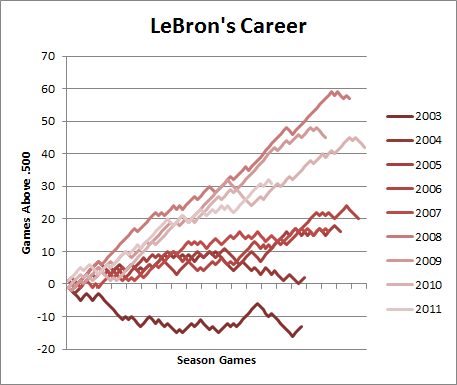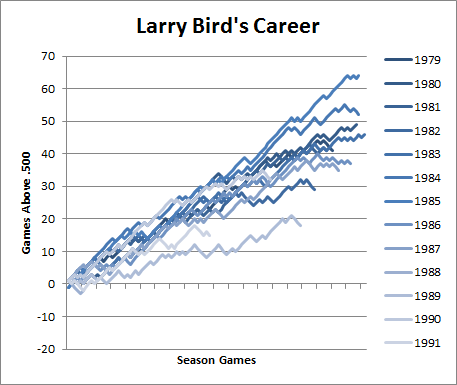So, over the weekend, I attended my second MIT Sloan Sports Analytics Conference. My experience was much different than in 2011: Last year, I went into this thing barely knowing that other people were into the same things I was. An anecdote: In late 2010, I was telling my dad how I was about to have a 6th or 7th round interview for a pretty sweet job in sports analysis, when he speculated, “How many people can there even be in that business? 10? 20?” A couple of months later, of course, I would learn.
A lot has happened in my life since then: I finished my Rodman series, won the ESPN Stat Geek Smackdown (which, though I am obviously happy to have won, is not really that big a deal—all told, the scope of the competition is about the same as picking a week’s worth of NFL games), my wife and I had a baby, and, oh yeah, I learned a ton about the breadth, depth, and nature of the sports analytics community.
For the most part, I used Twitter as sort of my de facto notebook for the conference. Thus, I’m sorry if I’m missing a bunch of lengthier quotes and/or if I repeat a bunch of things you already saw in my live coverage, but I will try to explain a few things in a bit more detail.
For the most part, I’ll keep the recap chronological. I’ve split this into two parts: Part 1 covers Friday, up to but not including the Bill Simmons/Bill James interview. Part 2 covers that interview and all of Saturday.
Opening Remarks:
From the pregame tweets, John Hollinger observed that 28 NBA teams sent representatives (that we know of) this year. I also noticed that the New England Revolution sent 2 people, while the New England Patriots sent none, so I’m not sure that number of official representatives reliably indicates much.
The conference started with some bland opening remarks by Dean David Schmittlein. Tangent: I feel like political-speak (thank everybody and say nothing) seems to get more and more widespread every year. I blame it on fear of the internet. E.g., in this intro segment, somebody made yet another boring joke about how there were no women present (personally, I thought there were significantly more than last year), and was followed shortly thereafter by a female speaker, understandably creating a tiny bit of awkwardness. If that person had been more important (like, if I could remember his name to slam him), I doubt he would have made that joke, or any other joke. He would have just thanked everyone and said nothing.
The Evolution of Sports Leagues
Featuring Gary Bettman (NHL), Rob Manfred (MLB), Adam Silver (NBA), Steve Tisch (NYG) and Michael Wilbon moderating.
This panel really didn’t have much of a theme, it was mostly Wilbon creatively folding a bunch of predictable questions into arbitrary league issues. E.g.: ” “What do you think about Jeremy Lin?!? And, you know, overseas expansion blah blah.”
I don’t get the massive cultural significance of Jeremy Lin, personally. I mean, he’s not the first ethnically Chinese player to have NBA success (though he is perhaps the first short one). The discussion of China, however, was interesting for other reasons. Adam Silver claimed that Basketball is already more popular in China than soccer, with over 300 million Chinese people playing it. Those numbers, if true, are pretty mind-boggling.
Finally, there was a whole part about labor negotiations that was pretty well summed up by this tweet:
Hockey Analytics
Featuring Brian Burke, Peter Chiarelli, Mike Milbury and others.
The panel started with Peter Chiarelli being asked how the world champion Boston Bruins use analytics, and in an ominous sign, he rambled on for a while about how, when it comes to scouting, they’ve learned that weight is probably more important than height.
Overall, it was a bit like any scene from the Moneyball war room, with Michael Schuckers (the only pro-stats guy) playing the part of Jonah Hill, but without Brad Pitt to protect him.
When I think of Brian Burke, I usually think of Advanced NFL Stats, but apparently there’s one in Hockey as well. Burke is GM/President of the Toronto Maple Leafs. At one point he was railing about how teams that use analytics have never won anything, which confused me since I haven’t seen Toronto hoisting any Stanley Cups recently, but apparently he did win a championship with the Mighty Ducks in 2007, so he clearly speaks with absolute authority.
This guy was a walking talking quote machine for the old school. I didn’t take note of all the hilarious and/or non-sensical things he said, but for some examples, try searching Twitter for “#SSAC Brian Burke.” To give an extent of how extreme, someone tweeted this quote at me, and I have no idea if he actually said it or if this guy was kidding.
In other words, Burke was literally too over the top to effectively parody.
On the other hand, in the discussion of concussions, I thought Burke had sort of a folksy realism that seemed pretty accurate to me. I think his general point is right, if a bit insensitive: If we really changed hockey so much as to eliminate concussions entirely, it would be a whole different sport (which he also claimed no one would watch, an assertion which is more debatable imo). At the end of the day, I think professional sports mess people up, including in the head. But, of course, we can’t ignore the problem, so we have to keep proceeding toward some nebulous goal.
Mike Milbury, presently a card-carrying member of the media, seemed to mostly embrace the alarmist media narrative, though he did raise at least one decent point about how the increase in concussions—which most people are attributing to an increase in diagnoses—may relate to recent rules changes that have sped up the game.
But for all that, the part that frustrated me the most was when Michael Schuckers, the legitimate hockey statistician at the table, was finally given the opportunity to talk. 90% of the things that came out of his mouth were various snarky ways of asserting that face-offs don’t matter. I mean, I assume he’s 100% right, but just had no clue how to talk to these guys. Find common ground: you both care about scoring goals, defending goals, and winning. Good face-off skill get you the puck more often in the right situations. The question is how many extra possessions you get and how valuable those possessions are? And finally, what’s the actual decision in question?
Baseball Analytics
Featuring Scott Boras, Scott Boras, Scott Boras, some other guys, Scott Boras, and, oh yeah, Bill James.
In stark constrast to the Hockey panel, the Baseball guys pretty much bent over backwards to embrace analytics as much as possible. As I tweeted at the time:
Scott Boras seems to like hearing Scott Boras talk. Which is not so bad, because Scott Boras actually did seem pretty smart and well informed: Among other things, Scott Boras apparently has a secret internal analytics team. To what end, I’m not entirely sure, since Scott Boras also seemed to say that most GM’s overvalue players relative to what Scott Boras’s people tell Scott Boras.
At this point, my mind wandered:
How awesome would that be, right?
Anyway, in between Scott Boras’s insights, someone asked this Bill James guy about his vision for the future of baseball analytics, and he gave two answers:
- Evaluating players from a variety of contexts other than the minor leagues (like college ball, overseas, Cubans, etc).
- Analytics will expand to look at the needs of the entire enterprise, not just individual players or teams.
Meh, I’m a bit underwhelmed. He talked a bit about #1 in his one-on-one with Bill Simmons, so I’ll look at that a bit more in my review of that discussion. As for #2, I think he’s just way way off: The business side of sports is already doing tons of sophisticated analytics—almost certainly way more than the competition side—because, you know, it’s business.
E.g., in the first panel, there was a fair amount of discussion of how the NBA used “sophisticated modeling” for many different lockout-related analyses (I didn’t catch the Ticketing Analytics panel, but from its reputation, and from related discussions on other panels, it sounds like that discipline has some of the nerdiest analysis of all).
Scott Boras let Bill James talk about a few other things as well: E.g., James is not a fan of new draft regulations, analogizing them to government regulations that “any economist would agree” inevitably lead to market distortions and bursting bubbles. While I can’t say I entirely disagree, I’m going to go out on a limb and guess that his political leanings are probably a bit Libertarian?
Basketball Analytics
Featuring Jeff Van Gundy, Mike Zarren, John Hollinger, and Mark Cuban Dean Oliver.
If every one of these panels was Mark Cuban + foil, it would be just about the most awesome weekend ever (though you might not learn the most about analytics). So I was excited about this one, which, unfortunately, Cuban missed. Filling in on zero/short notice was Dean Oliver. Overall, here’s Nathan Walker’s take:
This panel actually had some pretty interesting discussions, but they flew by pretty fast and often followed predictable patterns, something like this:
- Hollinger says something pro-stats, though likely way out of his depth.
- Zarren brags about how they’re already doing that and more on the Celtics.
- Oliver says something smart and nuanced that attempts to get at the underlying issues and difficulties.
- Jeff Van Gundy uses forceful pronouncements and “common sense” to dismiss his strawman version of what the others have been saying.
E.g.:
Zarren talked about how there is practically more data these days than they know what to do with. This seems true and I think it has interesting implications. I’ll discuss it a little more in Part 2 re: the “Rebooting the Box Score” talk.
There was also an interesting discussion of trades, and whether they’re more a result of information asymmetry (in other words, teams trying to fleece each other), or more a result of efficient trade opportunities (in other words, teams trying to help each other). Though it really shouldn’t matter—you trade when you think it will help you, whether it helps your trade partner is mostly irrelevant—Oliver endorsed the latter. He makes the point that, with such a broad universe of trade possibilities, looking for mutually beneficial situations is the easiest way to find actionable deals. Fair enough.
Coaching Analytics
Featuring coaching superstars Jeff Van Gundy, Eric Mangini, and Bill Simmons. Moderated by Daryl Morey.
OK, can I make the obvious point that Simmons and Morey apparently accidentally switched role cards? As a result, this talk featured a lot of Simmons attacking coaches and Van Gundy defending them. I honestly didn’t remember Mangini was on this panel until looking back at the book (which is saying something, b/c Mangini usually makes my blood boil).
There was almost nothing on, say, how to evaluate coaches, say, by analyzing how well their various decisions comported with the tenets of win maximization. There was a lengthy (and almost entirely non-analytical) discussion of that all-important question of whether an NBA coach should foul or not up by 3 with little time left. Fouling probably has a tiny edge, but I think it’s too close and too infrequent to be very interesting (though obviously not as rare, it reminds me a bit of the impassioned debates you used to see on Poker forums about whether you should fast-play or slow-play flopped quads in limit hold’em).
There was what I thought was a funny moment when Bill Simmons was complaining about how teams seem to recycle mediocre older coaches rather than try out young, fresh talent. But when challenged by Van Gundy, Simmons drew a blank and couldn’t think of anyone. So, Bill, this is for you. Here’s a table of NBA coaches who have coached at least 1000 games for at least 3 different teams, while winning fewer than 60% of their games and without winning any championships:
[table “8” not found /]
Note that I’m not necessarily agreeing with Simmons: Winning championships in the NBA is hard, especially if your team lacks uber-stars (you know, Michael Jordan, Magic Johnson, Dennis Rodman, et al).
Part 2 coming soon!
Honestly, I got a little carried away with my detailed analysis/screed on Bill James, and I may have to do a little revising. So due to some other pressing writing commitments, you can probably expect Part 2 to come out this Saturday (Friday at the earliest).








